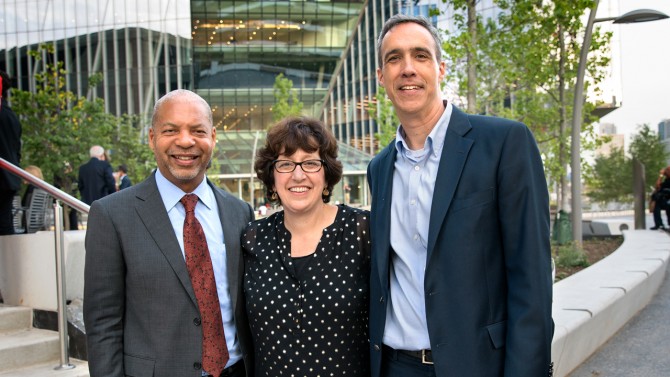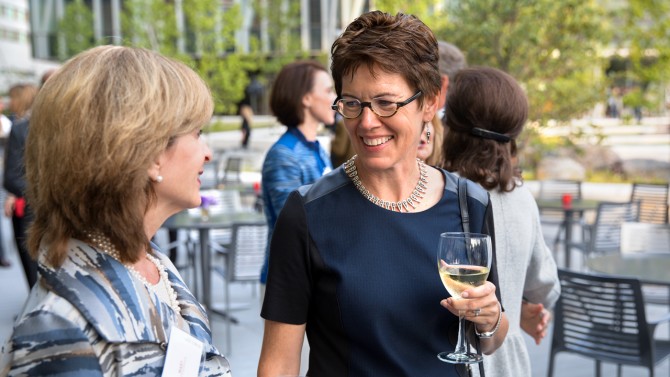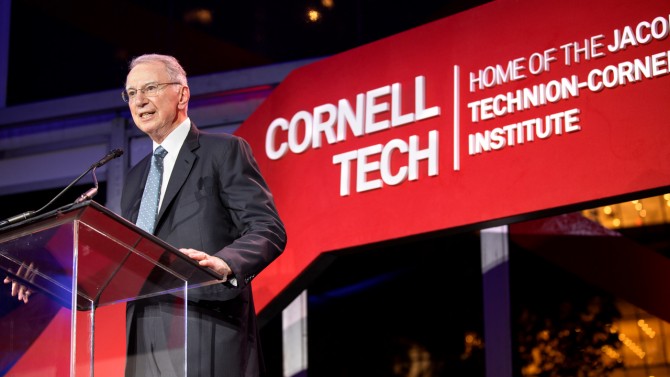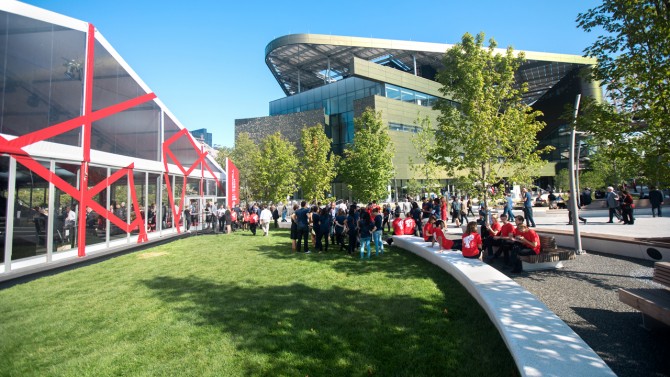
Guests attend a reception at the Cornell Tech campus Sept. 12, on the eve of the dedication.
Celebration guests extol Cornell Tech’s beauty, achievement and promise
By Joe Wilensky
On Roosevelt Island Sept. 12, on the eve of the Cornell Tech campus dedication, excitement was already building. Guests gathered on the new campus for a cocktail hour, art tours, live musical entertainment and a celebration dinner in a large tent that hosted the ribbon-cutting dedication ceremony the next morning.
They took in the beautiful weather, the striking campus and surrounding views, and paid tribute to the physical spaces and the academic culture within them.
“This is an unbelievable opportunity,” said Barbara Hempstead, senior associate dean of medical education at Weill Cornell Medicine. “Once our students understand the possibilities here, there’s going to be an invasion on this campus. Because they’re innovators. And that’s what this whole place is.
“We watched it go up, literally floor by floor by floor – but nothing beats being here,” she added. “There’s a serenity about it, which is really different than the hustle and bustle of a hospital in Manhattan. I think it’s gorgeous space.”
Said Matthew D’Amore ’91, a Cornell Law School professor of the practice at Cornell Tech who started teaching there this summer: “It’s an awesome faculty, very interdisciplinary, which is part of what attracted me to the program. It’s a small [law] program now, but they’re looking to grow each year. I hope lawyers will continue to be an integral part of the computer science, business and entrepreneurship programs they’re building here. There is a legal culture in New York that is very focused on that part of the economy, and we want to train lawyers to participate in it.”
Carol Epstein ’61 is a past president of the Cornell Club of Washington, D.C., an international board member of the Technion – Israel Institute of Technology, and a supporter of the Jacobs Technion-Cornell Institute. “This, to me, was a marriage made in heaven,” she said of Cornell’s partnership with Technion. “These are the two greatest institutions. … Now, you know I’m biased, but that doesn’t make what I just said not true.”
Epstein grew up in Queens. “I went over, and under, Roosevelt Island all the time I was growing up, and I was never actually on it,” she said. “I have followed the development of this campus, the construction and the architecture, and it’s just magnificent.”
Eduardo M. Peñalver ’93, the Allan R. Tessler Dean of Cornell Law School, said: “It’s an achievement – a beautiful architectural achievement. And we love that it’s connected to the Franklin D. Roosevelt Four Freedoms Park, which was spearheaded by one of our Law School alumni.” He noted that William J. vanden Heuvel ’52 was a former U.N. ambassador who launched the effort to get the 4-acre park built.
Marilyn Abrams ’57 and her husband, Robert Abrams ’56, are grandparents to Katie Dreier ’12, MBA ’15, a “double red” Cornellian who was recognized during the Sept. 13 dedication ceremony as representative of a growing cadre of Cornell Tech alumni who are making a difference in New York City. The Abramses are part of a multigenerational Cornell family, who have at least 10 Cornell degrees among three generations.
“I have chills. I have tears in my eyes,” Marilyn Abrams said. “When Cornell was selected, we were in high excitement – and now, to be here, it’s just unbelievable. And for us to have both been Cornellians … it’s just a wonderful feeling. And every single one of our grandchildren, everybody has loved it as much as we have.”
Jack Neafsey ’61, M.Eng. ’62, MBA ’63, and his wife, Rilla, just endowed the top academic leadership position at Cornell Tech held by Dan Huttenlocher, founding dean and vice provost.
Jack Neafsey said he was impressed with the buildings on campus but is even more enthused about the academic culture Huttenlocher helped create.
“In most of the cases where you become appointed the dean of something, there are models,” Neafsey said. “You had a predecessor, there are other schools similar to this … . Dan started with a blank piece of paper, and said, ‘We’re going to create a school that has no precedent. It’s going to be experimental, it’s going to be trial and error. The curriculum in the fifth year probably won’t look anything like the curriculum in the first year.’
“And it doesn’t – it didn’t even take a year to do it; they were changing things after the first month,” he said. “Dan has been innovative and creative. He wanted the best faculty; he is very solution-oriented, rather than precedent-oriented.” Cornell Tech is a “marvelous innovation, and we’re setting a model for everybody else.”
Judith Berdy is president of the Roosevelt Island Historical Society and has lived on the island, a tight-knit community of 14,000, for nearly four decades. She noted that an important part of the agreement with Cornell was that the community would be involved in planning campus construction to minimize disruption.
“They respected and involved our community,” she said. Roosevelt Islanders will benefit from Cornell Tech, “and I hope the students benefit from being on our island. They’ve all discovered our deli and our supermarket,” she noted with a laugh.
Dinner presentations and a note from Chuck Feeney
At the celebration dinner, speakers included Huttenlocher; Cornell President Martha E. Pollack; Cornell University Board of Trustees Chairman Robert S. Harrison ’76; former New York City Mayor Michael Bloomberg; president of Technion, Peretz Lavie; Irwin Jacobs ’54, founding chairman and CEO emeritus of Qualcomm; and Lowell McAdam ’76, Verizon chairman and CEO and chairman of the Cornell Tech Board of Overseers.
Two startup companies created at Cornell Tech gave brief presentations, demonstrating the technology applications that are being spun out of Cornell Tech’s Startup Studios: Uru, an “evolved” video advertising platform that uses computer vision and artificial intelligence; and Speech Up, a mobile speech therapy platform for children. Both won Cornell Tech Startup Awards.
Christopher Oechsli, president and CEO of The Atlantic Philanthropies, also spoke and read a note from the foundation’s creator, Charles Feeney ’56, whose $350 million gift to fund the first phase of the campus made Cornell Tech possible.
Feeney watched the ceremonies via livestream from San Francisco with his wife, Helga.
“My cup runneth over,” Feeney wrote. “Tonight is a very personal moment for me. Both Cornell University and New York City played a major role in my life. … Tonight’s opportunity to celebrate Big Red’s grand arrival in the Big Apple is, to say the least, exhilarating.”
The audience burst into hearty applause for Feeney, who for decades gave away billions of dollars anonymously.
“Our dedication of Cornell Tech tonight is the beginning,” Oechsli continued from Feeney’s note. “The campus has come alive, and my visions are already being met. Most gratifying for me is knowing that for decades Cornell Tech will be educating engineers, scientists, businesswomen and businessmen, entrepreneurs, artists and other professionals who are both brilliant and holistic.
“I envision Cornell enrolling students from around the globe and reminding them of the practice of giving while living … instilling in them the notion that they should contribute and give something back – giving of their time, giving of their talents and giving of their treasure in service to others.”
Feeney’s note closed by congratulating all who had made the evening’s celebration possible: “Your timely accomplishments on Roosevelt Island are amazing.”
Media Contact
Get Cornell news delivered right to your inbox.
Subscribe


